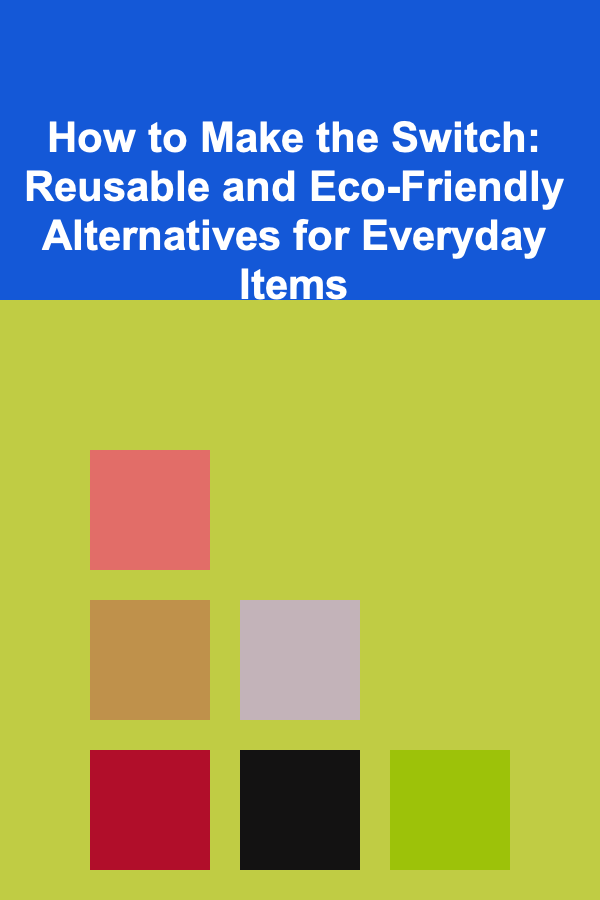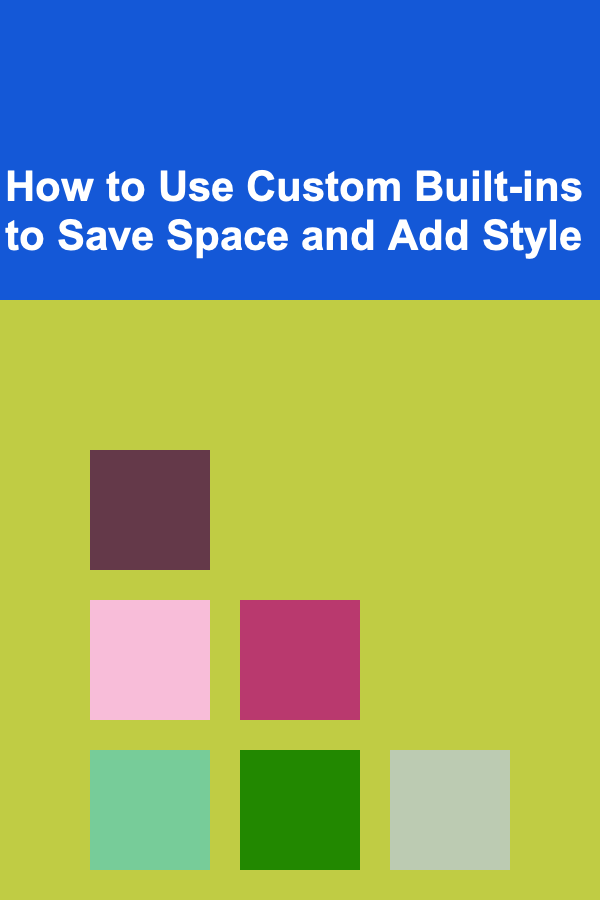
How to Make the Switch: Reusable and Eco-Friendly Alternatives for Everyday Items
ebook include PDF & Audio bundle (Micro Guide)
$12.99$5.99
Limited Time Offer! Order within the next:

In recent years, environmental sustainability has become a crucial topic of discussion. As awareness about the impact of single-use plastic and wasteful consumption grows, many people are looking for ways to reduce their ecological footprint. One of the most effective approaches is switching to reusable and eco-friendly alternatives for everyday items. These changes, though small on an individual level, can have a significant collective impact when adopted on a larger scale.
Making the switch to eco-friendly alternatives might seem daunting at first, but it's entirely achievable with the right mindset and knowledge. In this guide, we'll walk you through actionable steps to replace common household items with more sustainable options. From kitchen essentials to personal care products, we'll explore the best eco-friendly choices and how to integrate them into your daily life.
Start with the Basics: Why Switch to Reusable and Eco-Friendly Products?
Before we dive into specific items and alternatives, it's important to understand the reasoning behind this shift. The key motivations for making the switch include:
Environmental Impact
Single-use plastics are among the largest contributors to environmental degradation. They are not biodegradable, and their production leads to substantial pollution. Every year, millions of tons of plastic waste end up in our oceans, harming wildlife and ecosystems. By choosing reusable alternatives, we can reduce the demand for plastic production and reduce waste.
Economic Savings
While reusable alternatives may cost more upfront, they are often more durable and can save you money in the long run. For example, using a high-quality stainless-steel water bottle or bamboo straws can save you the cost of buying bottled water or disposable plastic straws over time.
Health Benefits
Some eco-friendly products are made from natural materials, which are often safer and healthier than synthetic, chemical-laden products. For example, reusable beeswax wraps can be used to store food instead of plastic wraps, which may leach harmful chemicals into your food.
Sustainable Kitchen Alternatives
The kitchen is one of the areas where eco-friendly changes can make a huge difference. Here are some everyday kitchen items and their sustainable alternatives:
Plastic Wrap vs. Beeswax Wraps
Plastic wrap is one of the most common household items that contribute to plastic waste. Beeswax wraps are a fantastic, reusable alternative. Made from cotton infused with beeswax, resin, and jojoba oil, these wraps are perfect for wrapping food, covering bowls, or even keeping your vegetables fresh. They are washable, durable, and biodegradable, making them a much better option for the environment.
Single-Use Paper Towels vs. Reusable Cloth Towels
Instead of using paper towels for spills or cleaning, consider switching to reusable cloth towels or rags. You can use old t-shirts, towels, or fabric scraps to make your own cleaning cloths. These cloths can be washed and reused multiple times, which reduces both waste and the need to buy paper towels constantly.
Plastic or Disposable Cutlery vs. Bamboo or Stainless Steel Cutlery
Everyday plastic cutlery adds to landfill waste after just one use. Instead, invest in reusable bamboo or stainless steel cutlery that can be used for years. These eco-friendly alternatives are sturdy, easy to clean, and can replace disposable cutlery when eating out or packing lunches.
Plastic Straws vs. Metal, Bamboo, or Silicone Straws
Plastic straws are another major contributor to pollution, particularly in the oceans. Metal, bamboo, or silicone straws are perfect alternatives that are both eco-friendly and durable. Many come with their own carrying cases, making them easy to take on the go.
Sustainable Personal Care Alternatives
Switching to reusable personal care items is another key step in reducing waste. Many single-use beauty and hygiene products contribute to plastic waste, but there are plenty of sustainable alternatives available.
Disposable Razors vs. Safety Razors
Most disposable razors are made with plastic and can't be recycled. A safety razor, on the other hand, is made of durable materials like stainless steel, and the razor blades can be recycled. By switching to a safety razor, you can significantly reduce your plastic consumption while achieving a close, comfortable shave.
Plastic Toothbrushes vs. Bamboo Toothbrushes
Traditional plastic toothbrushes are difficult to recycle and contribute to the waste problem. Bamboo toothbrushes are biodegradable, and the bamboo handles can break down naturally in the environment. Additionally, many bamboo toothbrushes have replaceable heads, which further reduces waste.
Plastic Bottled Shampoo vs. Solid Shampoo Bars
Shampoo bars are a fantastic eco-friendly alternative to traditional liquid shampoos packaged in plastic bottles. These solid bars last a long time, are highly concentrated, and can be stored without the need for plastic containers. Plus, they're often made from natural ingredients, which are better for your hair and the planet.
Cotton Pads vs. Reusable Cotton Pads
Cotton pads are often used for makeup removal or skincare, but they are single-use items that quickly add to your waste pile. Reusable cotton pads made from organic cotton, bamboo, or other eco-friendly materials are great alternatives. Simply wash them after each use, and they can last for months or even years.
Eco-Friendly Alternatives for Cleaning Products
Traditional cleaning products often come in plastic packaging and are loaded with chemicals that can harm the environment. Luckily, there are plenty of sustainable and non-toxic alternatives.
Chemical Cleaners vs. DIY Natural Cleaners
Instead of using store-bought chemical cleaning products, which often come in plastic bottles, try making your own cleaning solutions. Simple ingredients like vinegar, baking soda, lemon juice, and essential oils can be used to create effective, eco-friendly cleaners for your home. These DIY solutions are not only better for the environment but also safer for your family and pets.
Disposable Cleaning Wipes vs. Reusable Cleaning Cloths
Disposable cleaning wipes, whether for surfaces or personal hygiene, are often made of synthetic fibers that don't break down easily. Instead, opt for washable microfiber cloths or reusable cleaning rags. These are highly effective for cleaning and can be washed and reused many times.
Plastic Bottles vs. Concentrated Cleaning Solutions
If you prefer store-bought cleaning products, look for concentrated formulas that require less plastic packaging. You can mix the concentrated solution with water in your own reusable spray bottles. This way, you reduce the need for new plastic containers each time you buy a new product.
Eco-Friendly Clothing and Textiles
Fashion has a significant environmental footprint, with the fast fashion industry contributing to pollution and waste. Switching to eco-friendly clothing and textiles is an important way to reduce your environmental impact.
Fast Fashion vs. Sustainable Fashion
Fast fashion encourages overconsumption and leads to the production of cheap, poorly made garments that often end up in landfills. To combat this, choose sustainable clothing brands that focus on using organic or recycled materials and ethical production practices. Look for items made from natural fibers like cotton, hemp, or bamboo, which are more biodegradable than synthetic fabrics.
Dryer Sheets vs. Wool Dryer Balls
Most dryer sheets are single-use and contain chemicals that can harm the environment. Wool dryer balls are a reusable, natural alternative. These balls help reduce static, soften clothes, and speed up drying time without the need for chemical-laden dryer sheets.
Plastic Hangers vs. Wooden or Metal Hangers
Plastic hangers are often flimsy and can't be recycled. Wooden or metal hangers, however, are more durable and can last for years. Additionally, they are typically recyclable or biodegradable, making them a better choice for the environment.
Making the Transition: How to Start
Making the switch to reusable and eco-friendly alternatives doesn't need to happen overnight. Instead, start by gradually replacing single-use items with sustainable alternatives as your old products wear out. Here are some tips to ease into the transition:
Start Small
Begin with one or two products you use daily, such as a reusable water bottle or bamboo toothbrush. Once you feel comfortable with these changes, move on to other areas like cleaning supplies or kitchen items.
Educate Yourself
Learn about the materials and processes behind the products you buy. Look for certifications such as Fair Trade, B Corp, or organic labels to ensure the items are truly eco-friendly.
Buy Quality, Not Quantity
Investing in high-quality, durable items ensures they will last longer, reducing the need for replacements. Quality items often end up being more cost-effective in the long run because they won't need to be replaced as often.
Don't Be Too Hard on Yourself
Switching to an eco-friendly lifestyle can be challenging, but it's important to be patient with yourself. Every small change counts, and over time, these small actions can add up to significant environmental impact.
Conclusion
Switching to reusable and eco-friendly alternatives for everyday items is one of the most impactful steps we can take to reduce our ecological footprint. While it requires some effort and a shift in habits, the benefits for the environment, our health, and our wallets are well worth the investment. By starting with small changes and gradually incorporating more sustainable options into your daily routine, you can contribute to a greener, healthier planet for future generations.
Reading More From Our Other Websites
- [Home Renovating 101] How to Find Reliable Remodelers in Your Area
- [Home Staging 101] How to Create a Welcoming Living Room Through Staging
- [Home Pet Care 101] How to Make DIY Pet Toys for Fun and Enrichment
- [Organization Tip 101] How to Plan for Renovations Without Disrupting Tenants
- [Home Family Activity 101] How to Plan an Epic Family Game Night: Themes, Rules, and More
- [Organization Tip 101] How to Utilize Under-Bed Storage for Sports Equipment
- [Personal Investment 101] How to Confidently Analyze a Company's Financial Report for Beginners
- [Hiking with Kids Tip 101] From Dusk to Dark: Engaging Kids in Evening Wilderness Exploration
- [Tiny Home Living Tip 101] How to Choose the Perfect Tiny Home Layout for Small Families
- [Personal Investment 101] How to Use Property Management Services Wisely

How to Use Custom Built-ins to Save Space and Add Style
Read More
How to Use Social Media to Enhance Your Home Party Experience
Read More
Human Rights: Advocating for Dignity and Freedom for All
Read More
Product Marketing Manager's Handbook: Best Practices for Market Research and Product Promotion
Read More
The IT Manager's Guide: Mastering Technology Management and Strategic IT Solutions
Read More
How to Build Healthy Habits for Weight Loss
Read MoreOther Products

How to Use Custom Built-ins to Save Space and Add Style
Read More
How to Use Social Media to Enhance Your Home Party Experience
Read More
Human Rights: Advocating for Dignity and Freedom for All
Read More
Product Marketing Manager's Handbook: Best Practices for Market Research and Product Promotion
Read More
The IT Manager's Guide: Mastering Technology Management and Strategic IT Solutions
Read More